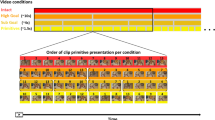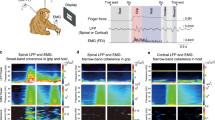Abstract
Many tasks require rapid and fine-tuned adjustment of motor performance based on incoming sensory information. This process of sensorimotor adaptation engages two parallel subcortico–cortical neural circuits, involving the cerebellum and basal ganglia, respectively1,2,3,4,5,6,7,8,9,10. How these distributed circuits are functionally coordinated has not been shown in humans. The cerebellum and basal ganglia show very similar convergence of input–output organization11,12, which presents an ideal neuroimaging model for the study of parallel processing at a systems level13. Here we used functional magnetic resonance imaging to measure the temporal coherence of brain activity during a tactile discrimination task. We found that, whereas the prefrontal cortex maintained a high level of activation, output activities in the cerebellum and basal ganglia showed different phasic patterns. Moreover, cerebellar activity significantly correlated with the activity of the supplementary motor area but not with that of the primary motor cortex; in contrast, basal ganglia activity was more strongly associated with the activity of the primary motor cortex than with that of the supplementary motor area. These results demonstrate temporally partitioned activity in the cerebellum and basal ganglia, implicating functional independence in the parallel subcortical outputs. This further supports the idea of task-related dynamic reconfiguration of large-scale neural networks14,15.
This is a preview of subscription content, access via your institution
Access options
Subscribe to this journal
Receive 51 print issues and online access
$199.00 per year
only $3.90 per issue
Buy this article
- Purchase on Springer Link
- Instant access to full article PDF
Prices may be subject to local taxes which are calculated during checkout




Similar content being viewed by others
References
Allen, G. I. & Tsukahara, N. Cerebrocerebellar communication systems. Physiol. Rev. 54, 957–1006 (1974).
Marsden, C. D. The mysterious motor function of the basal ganglia: The Robert Wartenberg Lecture. Neurology 32, 514–539 (1984).
Houk, J. C. & Wise, S. P. Distributed modular architecture linking basal ganglia, cerebellum, and cerebral cortex: their role in planning and controlling action. Cereb. Cortex 5, 95–110 (1995).
Ghez, C. in Principles of Neural Sciences (eds Kandel, E. R., Schwarts, J. H. & Jessel, T. M.) 609–625 (Elsevier, New York, 1991).
Rouiller, E. M. in Hand and Brain (eds Wing, A. M., Haggard, P. & Flanagan, J. R.) 99–124 (Academic, San Diego, 1996).
Hoover, J. E. & Strick, P. L. Multiple output channels in the basal ganglia. Science 259, 819–821 (1993).
Hoover, J. E. & Strick, P. L. The organization of cerebellar and basal ganglia outputs to primary motor cortex as revealed by retrograde transneuronal transport of herpes simplex virus type 1. J. Neurosci. 19, 1446–1463 (1999).
Middleton, F. A. & Strick, P. L. Dentate output channels: motor and cognitive components. Prog. Brain Res. 114, 553–566 (1997).
Middleton, F. A. & Strick, P. L. Anatomical evidence for cerebellar and basal ganglia involvement in higher cognitive function. Science 266, 458–461 (1994).
Houk, J. C. On the role of the cerebellum and basal ganglia in cognitive signal processing. Prog. Brain Res. 114, 543–552 (1997).
Voogd, J. & Ruigrok, T. J. H. Transverse and longitudinal patterns in the mammalian cerebellum. Prog. Brain Res. 114, 21–37 (1997).
Graybiel, A. M., Aosaki, T., Flaherty, A. W. & Kimura, M. The basal ganglia and adaptive motor control. Science 265, 1826–1831 (1994).
Churchland, P. S. & Sejnowski, T. J. Perspectives in cognitive neuroscience. Science 242, 741–745 (1988).
Bressler, S. L. Large-scale cortical networks and cognition. Brain Res. Rev. 20, 288–304 (1995).
Van Essen, D. C., Anderson, C. H. & Olshausen, B. A. in Large-Scale Neuronal Theories of the Brain (eds Kock, C. & Davis, J. L.) 271–299 (MIT Press, Cambridge, Massachusetts, 1994).
Kwong, K. K.et al . Dynamic magnetic resonance of human brain activity during primary sensory stimulation. Proc. Natl Acad. Sci. USA 89, 5675–5679 (1992).
Ogawa, S.et al . Functional brain mapping by blood oxygenation level-dependent contrast magnetic resonance imaging. J. Biophys. 64, 803–812 (1993).
Bandettini, P. A., Jesmanowicz, A., Wong, E. C. & Hyde, J. S. Processing strategies for time course data sets in functional MRI of the human brain. Magn. Reson. Med. 30, 161–173 (1993).
Gao, J. H.et al . Cerebellum implicated in sensory acquisition and discrimination rather than motor control. Science 272, 545–547 (1996).
Cohen, J. D.et al . Temporal dynamics of bran activation during a working memory task. Nature 386, 604–608 (1997).
Courtney, S. M., Ungerleider, L. G., Keil, K. & Haxby, J. V. Transient and sustained activity in a distributed neural system for human working memory. Nature 386, 608–611 (1997).
Houk, J. C., Keifer, J. & Barto, A. G. Distributed commands in the limb premotor network. Trends Neurosci. 16, 27–33 (1993).
Liu, Y.et al . Involvement of the human red nucleus in sensory discrimination. Proc. Int. Soc. Magn. Reson. Med. 6, 110 (1998).
Friston, K. J.et al . Analysis of fMRI time-series revised. NeuroImage 2, 45–53 (1995).
Biswal, B., Yetkin, F. Z., Haughton, V. M. & Hyde, J. S. Functional connectivity in the motor cortex of resting human brain using echo-planar MRI. Magn. Reson. Med. 34, 537–541 (1995).
Friston, K. J., Frith, C. D., Liddle, P. F. & Frackowiak, R. S. J. Functional connectivity: the principle-component analysis of large (PET) data sets. J. Cereb. Blood Flow Metab. 13, 5–14 (1993).
Roland, P. E., Eriksson, L., Widen, L. & Stone-Elander, S. Changes in regional cerebral oxidative metabolism induced by tactile learning and recognition in man. Eur. J. Neurosci. 1, 3–18 (1988).
Xiong, J., Gao, J. H., Lancaster, J. L. & Fox, P. T. Clustered pixels analysis for functional MRI activation studies of the human brain. Hum. Brain Mapp. 3, 287–301 (1995).
Fox, P. T. Spatial normalization: origins, applications, and alternatives. Hum. Brain Mapp. 4, 1–2 (1995).
Acknowledgements
We thank J. C. Houk for comments on the manuscript.
Author information
Authors and Affiliations
Corresponding author
Rights and permissions
About this article
Cite this article
Liu, Y., Gao, JH., Liotti, M. et al. Temporal dissociation of parallel processing in the human subcortical outputs. Nature 400, 364–367 (1999). https://doi.org/10.1038/22547
Received:
Accepted:
Issue Date:
DOI: https://doi.org/10.1038/22547
This article is cited by
-
Role of resting-state functional MRI in detecting brain functional changes following radiotherapy for head and neck cancer: a systematic review and meta-analysis
Strahlentherapie und Onkologie (2023)
-
A systematic review of resting-state and task-based fmri in juvenile myoclonic epilepsy
Brain Imaging and Behavior (2022)
-
Optimization of Recurrence Quantification Analysis for Detecting the Presence of Multiple Sclerosis
Journal of Medical and Biological Engineering (2019)
-
Big data analysis of the human brain’s functional interactions based on fMRI
Chinese Science Bulletin (2014)
-
Predictive Motor Timing Performance Dissociates Between Early Diseases of the Cerebellum and Parkinson's Disease
The Cerebellum (2010)
Comments
By submitting a comment you agree to abide by our Terms and Community Guidelines. If you find something abusive or that does not comply with our terms or guidelines please flag it as inappropriate.



